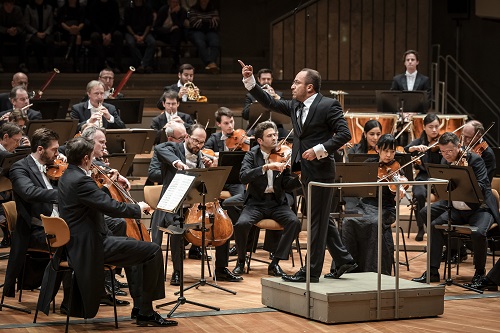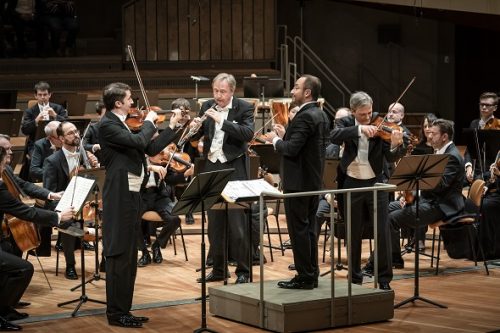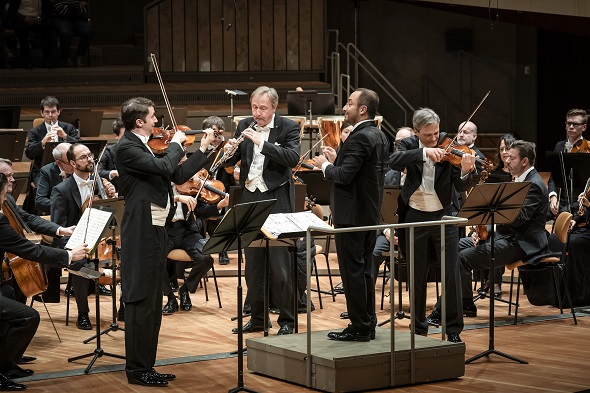 Germany Mozart: Noah Bendix-Bagley, Thomas Timm (violins), Berlin Philharmonic Orchestra / Riccardo Minasi (conductor). Philharmonie, Berlin, 27.10.2023. (MB)
Germany Mozart: Noah Bendix-Bagley, Thomas Timm (violins), Berlin Philharmonic Orchestra / Riccardo Minasi (conductor). Philharmonie, Berlin, 27.10.2023. (MB)

Mozart – Così fan tutte, KV 588, Overture; Symphony No.35 in D major, KV 385, ‘Haffner’; Concertone in C major for two violins and orchestra, KV 190/186e; Symphony No.40 in G minor, KV 550
A wonderful concert, this, in which Riccardo Minasi, making his debut with the Berlin Philharmonic, showed himself a musician who would not only listen to and learn from the orchestra, but also to and from every musician within it; and the orchestra and its musicians in turn listened to and learned from the musician in front of them. To say I am particular with Mozart would be something of an understatement. I hope that I, as a listener, also learned too; I certainly enjoyed the evening greatly. I might have done things a little differently in my head, but so what? The last thing one wants is for music-making to become a ritual, the same the world over. That would be the death of performance. This was just the tonic for a beastly October evening and indeed the horrors of the world around us.
The Overture to Così fan tutte set the tone, as it were, for the concert with warm, almost indescribably beautiful playing from the BPO (strings, as throughout, 12.10.8.6.4). Minasi took it fast, yet far from unreasonably so. There was a little woodwind ornamentation, which I did not mind, but some may have found fussy; coming from a woodwind section of this calibre, it is difficult to object.
The Haffner Symphony followed, timpani prominent, as indeed they had been in the overture, but underpinning the harmony rather than at the expense of others. This was a collegial performance all round. The first movement’s opening would surely have touched even the most reluctant of hearts — and set pulses racing. I could not help but notice the many benefits brought by modern trumpets (as opposed to the ‘period’ versions curiously employed by the Chamber Orchestra of Europe under Andrew Manze (review here) a few days earlier, in an otherwise modern set-up). The development section here can all too readily be overlooked; Minasi took it seriously, imparting to it something of its own, albeit related tintà, harmony and counterpoint admirably clear and directed. The recapitulation was upon us before we knew it, yet all had been changed in a performance that married detail and sweep through the most brilliant of orchestral playing. If the Andante was taken swiftly, it worked, and its detail was again unerringly articulated without pedantry. Here, from all contributors, was affectionate understanding. The Minuet was not only one-to-a-bar but a quick one-to-a-bar at that, yet never sounded rush, maintaining both grace and grandeur. Its flowing trio beguiled. Mozart is far less a Presto animal than Haydn, arguably even than Beethoven. In this finale he is, though. Minasi and the BPO showed with ease how one can take it at quite a lick and yet exude grace, humanity, chiaroscuro, and flexibility. Daniel Barenboim, in a rather different way, has shown in his performances of this and other Mozart symphonies exactly the same. The road that will absolutely never lead to Rome is that of dogmatism.

The C major Concertone is a true rarity. I had never heard it live previously, and the BPO had performed it just once before, in Brașov in 1938, conducted by Hans von Benda. (Such information is, by the way, a particular joy of the orchestra’s programmes.) Concertone, should anyone quite reasonably be wondering, is an Italian equivalent, used by Mozart here, for the more common French symphonie concertante, essentially a concerto with more than one soloist, and which in this case has as much in common with the older concerto grosso as it does the contemporary, let alone future, symphony. This is very much the Salzburg Mozart, whose music is in many ways as least as difficult to bring off as that of his Viennese successor, but not always in the same ways. What, in the wrong hands, can sound fussy was here a delight. The sheer profusion of melodic ideas was well served here in a lively and gracious performance, never driven hard. Solo playing, not only from the two violinists Noah Bendix-Bagley and Thomas Timm, but from other members of the BPO, but also oboist Albrecht Mayer (who stood with them), and cellist Ludwig Quant (who doubtless would have done, had he not been a cellist!) was beyond reproach, dialogue and conversation flowing in all directions. Tone was rich but never indulgent, like the finest Egyptian cotton The infectious spring in the step – to mix my metaphors – imparted to the first movement was Minasi’s work and helped propel the music with spirit. Not for nothing is it marked Allegro spiritoso.
Andantino grazioso, in character as much as speed, was likewise what we heard in the following movement. There was plenty of space for detail to have its full say, in a reading that breathed the air of a Salzburg summer evening. I could imagine myself at the old, dearly lamented Café Glockenspiel, eating a late, post-performance dinner as musicians played below. Similarly, in the minuet finale, I could almost see the ballroom and be dazzled by it, as if Vienna’s Redoutensaal were both already beckoning Mozart and yet also remained some way distant, this the work of his Salzburg imagination and perhaps occasional visit rather than everyday acquaintance. Here, as elsewhere, the two violinists complemented each other, blending well without losing individual character, Bendix-Bagley almost Grumiaux-like (an ideal for me in Mozart), Timm a little more silver of tone. Mayer, needless to say, was his usual excellent self. The whole orchestra excelled, which is just as it should be.
Last, we heard the ‘great’ G minor Symphony, its first movement neither forsaking emotion for elegance, nor vice versa; they were two sides to the same coin, showing Robert Schumann’s oft-quoted (and derided) imputation of ‘Grecian lightness and grace’ not so far off the mark as it is generally taken to be. Finely, not fussily, shaded, it also possessed a clear sense of line and trajectory. If not so overtly grounded in harmony as, say, with Barenboim, that necessity was still respected. The shockingly Schoenbergian disorientations of the development disoriented as they should; its moments of fragility frightened, if anything, still more. The same should also be said of the coda. In between, the coming of the recapitulation sounded, quite properly, transformed from initial appearances of its material. Form, then, was dynamic, as it must be. The slow movement flowed gracefully, without skating over anything. Breathtaking passages of inwardness contrasted starkly, indeed with great daring from conductor and players alike, with vehement responses that approached yet never quite reached Beethoven. Were it not for its Schubertian heavenly length, both repeats taken, it might have been even more akin to what Schumann and Brahms would have considered an intermezzo, albeit structurally only ever itself.
Fast and furious, yet still light on its feet, the Minuet’s insistence sounded still closer to Beethoven — because it is. The trio was lovely, yet just a touch unsteady, its tempo stretched before it had been established. That was a very rare misstep, though, and quite a minor one. Playing remained beyond reproach. The finale, naturally, was still faster and at least as furiously insistent, yet that Schumann Grecian quality persisted. The second group led so ravishingly by first clarinet Wenzel Fuchs, had me especially grateful that Minasi had opted for the second version, with clarinets, of the work. The development showed that form and rhetoric, properly understood, are complementary, not antithetical, Beethovenian strength of purpose uniting all, and perfectly preparing the moment of return, tragic in a way few composers before or since have approached let alone matched. The second repeat was taken, as Barenboim now does too. Both conductors have made sense of something that others do not — and about which I remain a little sceptical ‘on paper’. For Minasi’s ‘recapitulation’ did so much more than recapitulate or repeat; second time around, it proved a ghostly, terrifying experience.
When Sir Colin Davis became chief conductor of the London Symphony Orchestra, he said one of the things he intended to do – and he was true to his word – was have them play more Mozart and Haydn, not only as a good in itself but also for what it would do for the orchestra’s string tone in particular. The Berlin Philharmonic hardly needs help in that department, but all orchestras need to maintain, indeed to extend, their capabilities in this and every other regard. I cannot offhand think of a single symphony orchestra that does not at present at least slightly neglect these composers. All would benefit from doing so, not least since the Western symphonic tradition stands on their shoulders; and if, somehow, they find themselves at a loss for someone to lead them in this music, on this basis they could do far worse than engage Riccardo Minasi as a guest conductor.
Mark Berry
